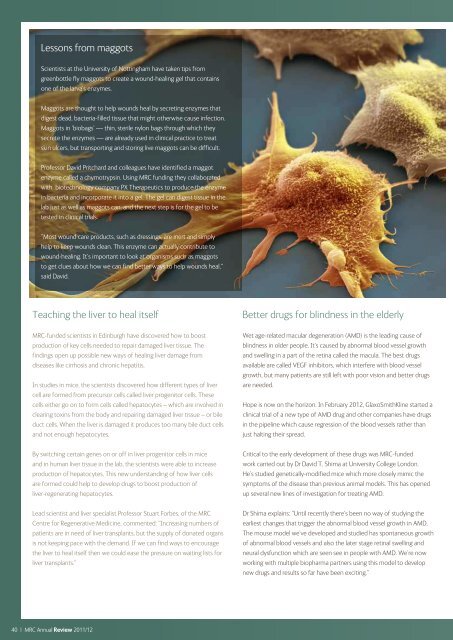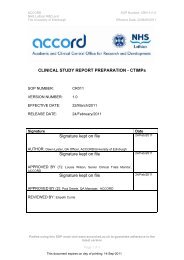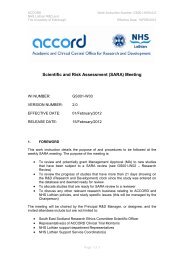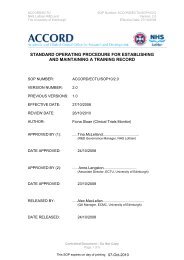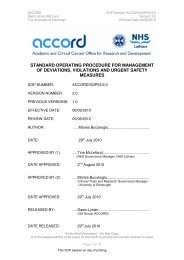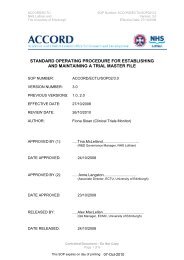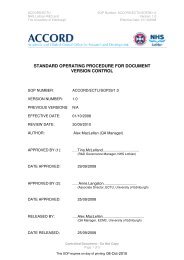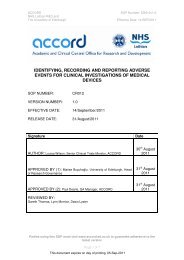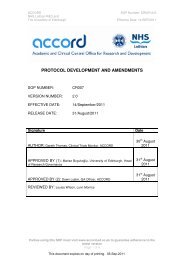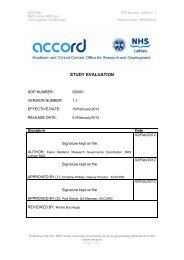Advancing medicine, changing lives - Medical Research Council
Advancing medicine, changing lives - Medical Research Council
Advancing medicine, changing lives - Medical Research Council
You also want an ePaper? Increase the reach of your titles
YUMPU automatically turns print PDFs into web optimized ePapers that Google loves.
Lessons from maggots<br />
Scientists at the University of Nottingham have taken tips from<br />
greenbottle fly maggots to create a wound-healing gel that contains<br />
one of the larva’s enzymes.<br />
Maggots are thought to help wounds heal by secreting enzymes that<br />
digest dead, bacteria-filled tissue that might otherwise cause infection.<br />
Maggots in ‘biobags’ — thin, sterile nylon bags through which they<br />
secrete the enzymes — are already used in clinical practice to treat<br />
skin ulcers, but transporting and storing live maggots can be difficult.<br />
Professor David Pritchard and colleagues have identified a maggot<br />
enzyme called a chymotrypsin. Using MRC funding they collaborated<br />
with biotechnology company PX Therapeutics to produce the enzyme<br />
in bacteria and incorporate it into a gel. The gel can digest tissue in the<br />
lab just as well as maggots can, and the next step is for the gel to be<br />
tested in clinical trials.<br />
“Most wound care products, such as dressings, are inert and simply<br />
help to keep wounds clean. This enzyme can actually contribute to<br />
wound-healing. It’s important to look at organisms such as maggots<br />
to get clues about how we can find better ways to help wounds heal,”<br />
said David.<br />
Teaching the liver to heal itself<br />
MRC-funded scientists in Edinburgh have discovered how to boost<br />
production of key cells needed to repair damaged liver tissue. The<br />
findings open up possible new ways of healing liver damage from<br />
diseases like cirrhosis and chronic hepatitis.<br />
In studies in mice, the scientists discovered how different types of liver<br />
cell are formed from precursor cells called liver progenitor cells. These<br />
cells either go on to form cells called hepatocytes – which are involved in<br />
clearing toxins from the body and repairing damaged liver tissue – or bile<br />
duct cells. When the liver is damaged it produces too many bile duct cells<br />
and not enough hepatocytes.<br />
By switching certain genes on or off in liver progenitor cells in mice<br />
and in human liver tissue in the lab, the scientists were able to increase<br />
production of hepatocytes. This new understanding of how liver cells<br />
are formed could help to develop drugs to boost production of<br />
liver-regenerating hepatocytes.<br />
Lead scientist and liver specialist Professor Stuart Forbes, of the MRC<br />
Centre for Regenerative Medicine, commented: “Increasing numbers of<br />
patients are in need of liver transplants, but the supply of donated organs<br />
is not keeping pace with the demand. If we can find ways to encourage<br />
the liver to heal itself then we could ease the pressure on waiting lists for<br />
liver transplants.”<br />
Better drugs for blindness in the elderly<br />
Wet age-related macular degeneration (AMD) is the leading cause of<br />
blindness in older people. It’s caused by abnormal blood vessel growth<br />
and swelling in a part of the retina called the macula. The best drugs<br />
available are called VEGF inhibitors, which interfere with blood vessel<br />
growth, but many patients are still left with poor vision and better drugs<br />
are needed.<br />
Hope is now on the horizon. In February 2012, GlaxoSmithKline started a<br />
clinical trial of a new type of AMD drug and other companies have drugs<br />
in the pipeline which cause regression of the blood vessels rather than<br />
just halting their spread.<br />
Critical to the early development of these drugs was MRC-funded<br />
work carried out by Dr David T. Shima at University College London.<br />
He’s studied genetically-modified mice which more closely mimic the<br />
symptoms of the disease than previous animal models. This has opened<br />
up several new lines of investigation for treating AMD.<br />
Dr Shima explains: “Until recently there’s been no way of studying the<br />
earliest changes that trigger the abnormal blood vessel growth in AMD.<br />
The mouse model we’ve developed and studied has spontaneous growth<br />
of abnormal blood vessels and also the later stage retinal swelling and<br />
neural dysfunction which are seen see in people with AMD. We’re now<br />
working with multiple biopharma partners using this model to develop<br />
new drugs and results so far have been exciting.”<br />
Alcohol damage study sheds light<br />
on rare disease<br />
Insights into how alcohol damages DNA – and how our cells defend<br />
themselves against it – have given scientists clues on how to tackle a<br />
rare disease.<br />
Studies in mice carried out at the MRC Laboratory of Molecular Biology<br />
in Cambridge showed that excess levels of acetaldehyde, produced<br />
when alcohol is broken down by our liver, cause irreparable damage<br />
to DNA.<br />
Further research uncovered a two-tier defence system in cells to<br />
protect against this damage. Firstly, cells produce specialised enzymes<br />
to break down and remove acetaldehyde. If this step fails, a second<br />
mechanism kicks in to repair the damaged DNA using another set of<br />
enzymes known as the Fanconi proteins. In pregnant mice which were<br />
unable to produce either set of enzymes, alcohol consumption caused<br />
catastrophic damage to the fetus.<br />
This suggests that people with a rare disease called Fanconi’s anaemia,<br />
who lack these DNA repair enzymes, are likely to be especially<br />
sensitive to acetaldehyde. This could explain why these individuals are<br />
susceptible to blood disorders and cancer.<br />
Lead scientist Dr Ketan J Patel said: “This new knowledge transforms<br />
our view of precisely how excess alcohol causes damage – ultimately<br />
<strong>changing</strong> our DNA. Quite apart from this, our conclusions suggest<br />
potentially simple approaches to treat Fanconi’s anaemia – currently a<br />
terminal incurable illness in humans.”<br />
Helping patients with liver damage<br />
Liver disease is one of the major causes of death in the UK and is<br />
currently on the rise. A technique called liver dialysis can be used to help<br />
patients whose livers have been damaged through disease and who<br />
are unable to rid the blood of toxic or unwanted substances. Now,<br />
with MRC funding, scientists are developing a new, improved type of<br />
dialysis system.<br />
Liver dialysis treatment is not easily accessible to all patients, and where<br />
it is available it can only help patients with very specific liver conditions<br />
including drug toxicities or symptoms such as pruritus, a disorder that<br />
leaves sufferers with uncontrollable itching.<br />
MRC researcher Dr Nathan Davies is working with dialysis company<br />
Gambro, University College London and the Royal Veterinary College to<br />
develop a new dialysis system which will be able to help all liver patients.<br />
A key feature is that the device will work with existing kidney dialysis<br />
machines so hospitals won’t need to purchase additional equipment.<br />
Dr Davies commented: “Funding from the MRC is ideally suited for this<br />
project and the next step will be to test the machine in clinical trials.<br />
We ultimately hope that liver dialysis will be available to all patients that<br />
need it.”<br />
40 | MRC Annual Review 2011/12 MRC Annual Review 2011/12 | 41


